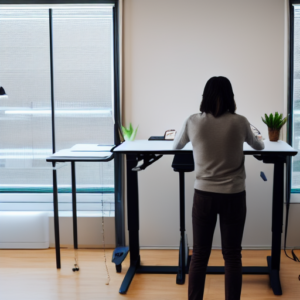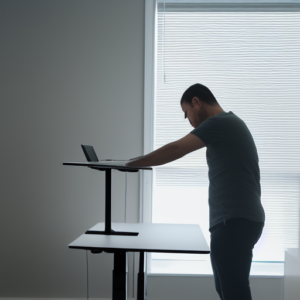Here’s How A Standing Desk Could Help Your Sciatica
Long workweeks are painful enough as it is, but when you have a sciatica flare-up, sitting at a desk all day can be downright miserable.
Sciatica is a specific type of pain that happens when something—like a herniated disc or a bone spur—puts pressure on your sciatic nerve, which extends from your lower spine all the way to your feet. This can cause burning pain, tingling, or numbness that affects your lower back, legs, or feet. (Do those symptoms sound familiar? Here are 5 ways to tell if you have sciatica.)
Some people swear a standing desk can offer relief from sciatica symptoms at work—but how helpful is it, really? Here’s what you need to know before you ditch your desk chair for good.
Too much sitting can aggravate sciatica.
If you sprain your ankle, it’s a smart idea to sit on the couch with your foot propped up. But when you’re dealing with sciatica pain, sitting can actually worsen your symptoms—especially sitting in an office chair for eight hours a day. (These 6 stretches can help if you’re stuck at a desk.)
“Sitting places a large amount of stress on the discs between the vertebrae,” says Payam Farjoodi, MD, an orthopedic spine surgeon at the Spine Health Center at MemorialCare Orange Coast Medical Center in Fountain Valley, CA. “This can cause increased inflammation and aggravate an already compressed nerve.”
How a standing desk can help.
During a sciatica flare-up, you may not exactly be in get-up-and-go mode, but it’s important to keep moving because exercise is actually one of the most effective solutions for sciatica pain. That’s where all the hype around a standing desk comes into play since it forces you to (literally) get off your butt.
“A standing desk can help to alleviate the symptoms from sciatica,” says Chris Wolf, DO, a sports medicine and regenerative orthopedic specialist at Bluetail Medical Group in St. Louis, MO. “Standing can remove the pressure being placed on the nerve.”
If your sciatic pain is relentless, this 30-second stretch may give you the instant relief you need:
Standing desks aren’t a magic cure.
 Yes, they can be helpful—but just like you don’t want to sit still all day, you don’t want to stand still all day, either.
Yes, they can be helpful—but just like you don’t want to sit still all day, you don’t want to stand still all day, either.
To maximize the benefits of a standing desk, you need to keep moving. “Maintaining any one position for too long is not good,” Farjoodi says. “Standing tends to be less troublesome [than sitting] for sciatica, but it is important to alternate between positions for overall spine health.”
Step away from the desk every 20 minutes to stretch your muscles or walk a quick lap around the office. And check your posture while you’re standing, because poor posture can make sciatica symptoms worse. (Here are 5 yoga fixes for bad posture.) You may also want to consider a sit-to-stand desk, which lets you adjust the height of your desk throughout the day so you’re not stuck in any single position for too long.
You’re not doomed if you can’t get one.
If you’re stuck in an ergonomically-challenged, cookie-cutter cubicle and there’s zero chance your employer is going to spring for a more sciatica-friendly desk, don’t worry: There are still a few simple steps you can take to alleviate the pain.
sciatica-friendly desk, don’t worry: There are still a few simple steps you can take to alleviate the pain.
“While sitting, make sure your feet are touching the floor, and avoid crossing your legs,” Wolf says. “Set your monitor at a comfortable height, and place your work at a comfortable distance to avoid leaning forward, which further worsens the pain.” And think about tasks you can do while standing, even at a traditional desk—like brainstorming or making phone calls. Your spine will thank you.
Sciatica is not always sciatica. Read this article to see what else it could be. Also, here’s an article filled with homeopathic remedies.







